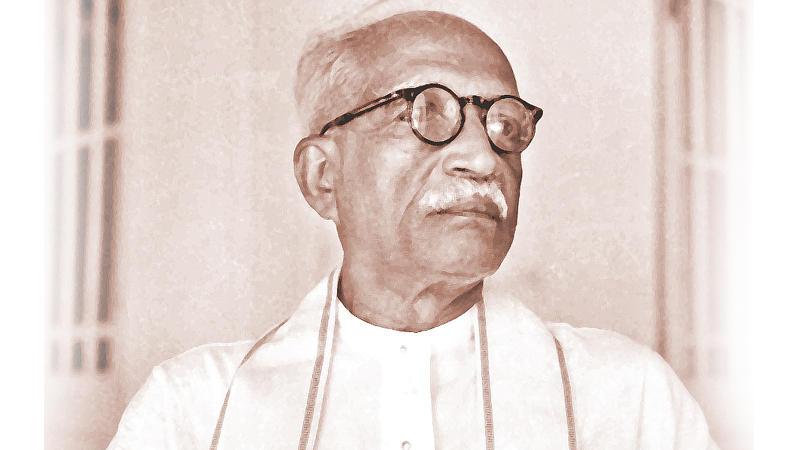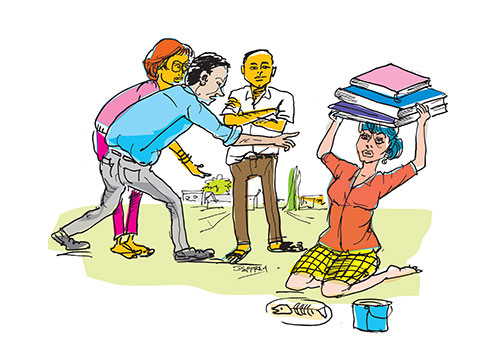By Erandika de Silva
This short piece is based on an anecdote of a striking memory that I have of a particular classroom at the Faculty of Arts, University of Peradeniya. Every time I walk past this particular classroom, it triggers the same memory and it has still not weathered. In this piece, I look back on this memory self-critically, in an attempt to understand my own self and analyze my thought process at the time of this incident. About nine years ago, as I walked past this lecture room, as an undergraduate, I saw a young woman, understood to be a student, inside, wearing an abaya, standing, facing the two walls of the interior corner. It was an unusual sight and I was taken aback by it. So, I walked a few steps backwards, just to have another look. I saw the girl unrolling a mat and kneeling down to pray. In a flash, I wondered what would happen if a lecturer walked into that classroom for a lecture; would the lecturer wait for this girl to finish her prayers; would the young woman even notice the lecturer until her prayers are over; can people simply go and pray in a lecture room; is the university not a secular space? In retrospect, I view my reaction to this incident as part of a modern problem.
A question that never occurred to me, at that point, was whether I would be amused, let alone be equally amused, by an undergraduate who practises Buddhist rituals of worship on campus. In retrospect, I am certain that it was never the practice of religion that unsettled me, but rather the practice of Islamic worship – a religion that is non-Buddhist. Then, the problem, to me, was a non-Buddhist practicing religion on campus rather than a student performing religious worship on campus. In Hegelian terms, I would say that it is the master’s recognition of the bondsman – the subject who should not publicly practice religion. It was a matter of Islam-ing instead of Buddhist-ing. The question is why Islam-ing was a problem (to me) when Sinhala-Buddhist-ing was not seen as a problem in the same university space that I deemed “secular”. The fact of Muslim-ness (?) was something I was not ready to grapple with as a deluded “modern” rational individual.
I am seeking to contribute to some introspective and reconstructive intellectual labour that can (perhaps) unpack the image of the Islam-ing female student on campus. As I revisit this memory, I realize how gendered this memory is: It is gendered in the sense that if it were a male student, it would be the figuration of the terrorist whereas it is the irrational Other in the case of the female student. The problem is that the Sinhala-Buddhist body as the normative human being/self cannot exist without the degradation of what is not Sinhala-Buddhist.
I wondered why this Muslim student chose to worship in a lecture room and not in the university mosque. Does the supposedly secular space of the university provide an alternative form of cultural-political order that makes it a safe place for a student to pray in public, or is it the Muslim student’s resistance to the liminal status imposed on her in the normative cultural-political order of a Sinhala-Buddhist dominated university? The mosque on campus is too far from the Faculty of Arts and the prayer rooms in the Faculty could accommodate only about five people at a time. In my view, the praying student perhaps resisted the idea of worshipping in territories assigned to her by the limits of her religion and gender, but most importantly the normative cultural-political order of a Sinhala-Buddhist dominated university. She dictated her own terms of worship as she exercised what it is to be human. It is perhaps a form of what Sylvia Wynter calls “ontological sovereignty” that this woman exercises. She is aware of the problem of sovereignty and refashions herself to come out of degradation – degradation that arises by abiding by the cultural-political order of the Sinhala-Buddhist polity. Her praying in public could be a way of coming out of degradation arising out of all the literature, history and discourse that tell her to view herself as the irrational Other who prays in public, the female counterpart of the figuration of the terrorist. Apprehensive about the irrational female Other, I thought I was enlightened and rational for trying to connect with some pseudo-intellectual understanding of the world of “man”.
The body of this praying woman is marked off as the “Muslim body” due to her religious attire and her practicing of religion in a public space that is deemed secular, at least, in principle. Her body becomes a problem in the dialectic of “us” and “them” that marks her off as the Other. She is located within a political community and a set of social relations in which she is always already known in the negative. It is because her identity is structured from the gaze of the modern wo/man that shapes the Muslim body through the reiteration of negative stereotypes. In this case, her identity is structured through my Sinhala-Buddhist gaze that recognizes and desires the subordination of the Muslim body. I assume the role of “man” by showing allegiance to the world of “men” who believe in the European construct of the rational. She is the praying “irrational” Other who needs to be subordinated for the triumph of the “secular”. In the larger world, I am as irrational an Other as she is due to my racialized, ethnicized and gendered body. Yet, as the “secular” and the “rational” are constructs that are used for the subordination of the racial Other in any given context, the praying Muslim girl is now the irrational female Other. A question worth asking is whether modern biopolitics capitalizes on secularization to promote one kind of secularism or the kind of secularism endorsed by the majority. For instance, in the context of the University of Peradeniya, it is a secularism endorsed by the Sinhala-Buddhist polity: a secularism that remembers it is secular only when its Sinhala-Buddhist foundation is threatened.
Practising religion in public becomes a problem as the norm is secularity. Is the practice of religion and culture the anomaly then? As democracy upholds the principles of representative government, majoritarian politics produces dangerous effects on the populace of nation states. Majoritarianism irons out differences and pushes the minorities to the periphery leaving them with little to no room for participation in society. Aspects of culture such as religion, customs and traditions, and language became increasingly problematic and created tensions in modernity as secularity became the point of orientation.
In the Sri Lankan context, the “Muslim body” creates a disconcertion in the Sinhala-Buddhist polity. The “global war on terror” and the Muslim overpopulation myth are two reasons for this. In the recent past, Sri Lanka was on a rampage for instituting ‘one country, one law’ on the pretext of maintaining civic and political order. Yet, it is clearly a matter of majoritarianism and majoritarian politics attempting at lobbying to institute a law that is advantageous to the Sinhala Buddhist polity by eliminating other forms of religious and legal systems of the non-Sinhala-Buddhists. It adopts the grand narrative of secularity, rationality and the Euro-American idea of progress as a way forward. Yet, rather than progress, it is an illusion of progress and civilization promoted through the idea of the universalism of occidental rationality and secularity. Unquestioningly adopting this myopic Euro-American idea of secularizing Sri Lanka does not guarantee progress but further establishes a backwater producing relations of domination and subordination thereby marginalizing non-Sinhala-Buddhist groups.
As much as secularization is oppressive, so is any compulsion to be what may be seen as religious and other cultural impositions and curtailment. Today, as I write as a teacher who is constantly worried about the rights and freedoms of my students, I would like to end this short piece with these thoughts: To pray or not to pray is not the question; to pray or not to pray is a right of my students, and of everyone. Rather the question is on what terms are we going to battle domination, imposition, curtailment and the question of the Other. This is where we need to begin. We need to begin from the position where we approach the question of identity as a political question, and not as a cultural question. This inquiry I hope can happen in our university spaces.



